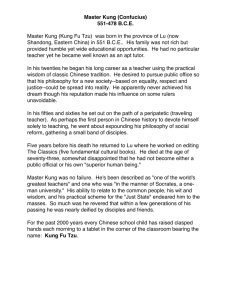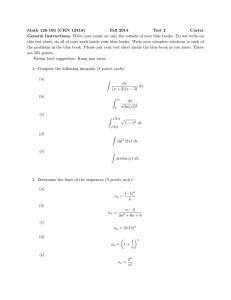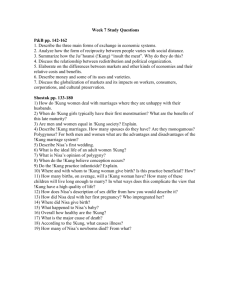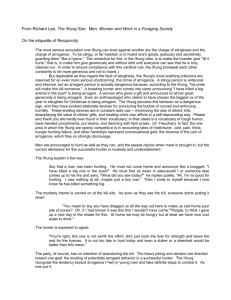4.605 Global History of Architecture - MIT Spring 2012 -... TAs: Mohamad A. Chakaki, Igor Demchenko, Michael Kubo
advertisement
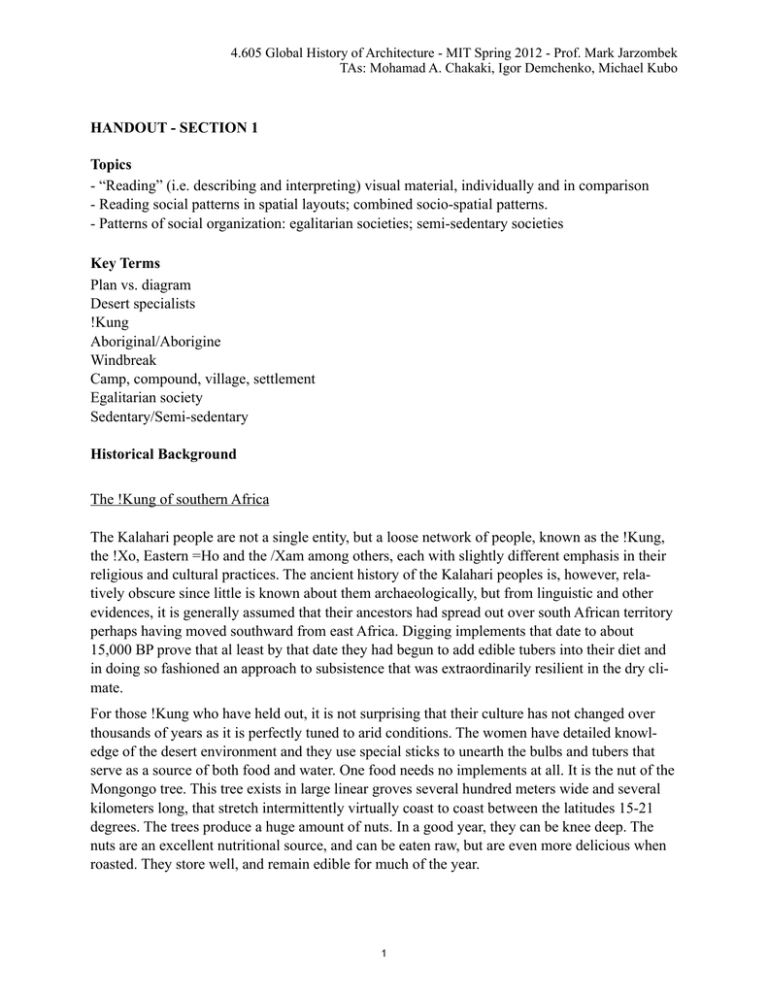
4.605 Global History of Architecture - MIT Spring 2012 - Prof. Mark Jarzombek TAs: Mohamad A. Chakaki, Igor Demchenko, Michael Kubo HANDOUT - SECTION 1 Topics - “Reading” (i.e. describing and interpreting) visual material, individually and in comparison - Reading social patterns in spatial layouts; combined socio-spatial patterns. - Patterns of social organization: egalitarian societies; semi-sedentary societies Key Terms Plan vs. diagram Desert specialists !Kung Aboriginal/Aborigine Windbreak Camp, compound, village, settlement Egalitarian society Sedentary/Semi-sedentary Historical Background The !Kung of southern Africa The Kalahari people are not a single entity, but a loose network of people, known as the !Kung, the !Xo, Eastern =Ho and the /Xam among others, each with slightly different emphasis in their religious and cultural practices. The ancient history of the Kalahari peoples is, however, relatively obscure since little is known about them archaeologically, but from linguistic and other evidences, it is generally assumed that their ancestors had spread out over south African territory perhaps having moved southward from east Africa. Digging implements that date to about 15,000 BP prove that al least by that date they had begun to add edible tubers into their diet and in doing so fashioned an approach to subsistence that was extraordinarily resilient in the dry climate. For those !Kung who have held out, it is not surprising that their culture has not changed over thousands of years as it is perfectly tuned to arid conditions. The women have detailed knowledge of the desert environment and they use special sticks to unearth the bulbs and tubers that serve as a source of both food and water. One food needs no implements at all. It is the nut of the Mongongo tree. This tree exists in large linear groves several hundred meters wide and several kilometers long, that stretch intermittently virtually coast to coast between the latitudes 15-21 degrees. The trees produce a huge amount of nuts. In a good year, they can be knee deep. The nuts are an excellent nutritional source, and can be eaten raw, but are even more delicious when roasted. They store well, and remain edible for much of the year. 1 4.605 Global History of Architecture - MIT Spring 2012 - Prof. Mark Jarzombek TAs: Mohamad A. Chakaki, Igor Demchenko, Michael Kubo The !Kung are not want of meat. In fact, they are perfectly positioned in the overlap of areas where the kudu, wildebeest, giraffe and antelope migrate. Since these herds need water just as much as humans their movements are predictable. There are, after all, just so many water holes and springs. The bows and arrows of the hunters may not be big, but the poisoned tips are lethal. Once dazed by the poison, the animals are swiftly dispatched with spears and axes. The meat, including liver and heart, is roasted immediately with parts of the animal brought back to the camp including the head, which is cooked communally. Aborigines of Australia At the time of the landing of the Europeans, it is thought that there were some 300,000 people on the continent, but there were probably more. Though there are numerous different tribes and groupings, the basic family unit is always a man, his wife or wives, and their children. Strong bonds also exist, however, between its members and members of the local group. Though much of life is spent in the context of family units, occasionally people gather in larger groups of dozens or perhaps even hundreds of people for special purposes. Hunting and gathering techniques vary depending on the local ecology. In the arid interior of the continent, hunters use little in the way of equipment so as not to be burdened in their search. Near the sea and along the big inland rivers where it is possible to lead a much more settled existence, people use nets, fishing lines and canoes. Food ranges from bird eggs, small mammals, lizards, edible grubs, palm nuts, honey, and, when possible, fish. The hunt has important cultural significance for the men, but women are often the chief food-suppliers. Though often described as nomads, in actuality, Australian people move between a number of contiguous ecological systems to exploit seasonal foods and resources; furthermore, the geographical range of the various groups is in most areas are restricted by territorial rules. People are conscious of their place within their local territory, intimate with its geography and spiritually attached to its sacred sites and histories. People often prefer to live and sleep in the open when possible, but are very adept in making shelters and in places where there are abundant food resources. There is a strong tendency toward permanent settlements. This has led to a great deal of differentiation. The native Australians speak over two hundred different languages and hundreds of associated dialects. The !Kung and Aborigines, contrasted Differences between Aborigines and the !Kung are profound. For the !Kung, a hut was a relatively generic device, whereas for the Aborigines, the windbreaker, as informal as it might seem, defined a piece of social geography designed around the specific set of people it protects. It could be bigger or smaller. Furthermore, the central fire which played such an important symbolic role for the !Kung, is not as prominent for the Australians. A fire was set up in front of the 2 4.605 Global History of Architecture - MIT Spring 2012 - Prof. Mark Jarzombek TAs: Mohamad A. Chakaki, Igor Demchenko, Michael Kubo windbreaker, but there was no common fire at the conceptual center of the group. Separate shelters are commonly used for diurnal and nocturnal activities. During the day, men and women congregate apart, while the families resided together at night protected by huts or windbreakers. During the dry season, people sleep on the ground in a row between small fires. The windbreakers, and when needed their associated huts, are designed close enough for visual and aural communication, but far enough to allow for the personal and social activities around each area. Camps are often sited near a source of water and firewood. A site is also chosen on a clear area where there is good visibility to guard against intruders. Warm and sandy ground is preferred. There are also different types of camps, serving various economic, social or ceremonial functions. Additional Bibliography Paul Memmott, Gunyah, Goondie and Wurley: The Aboriginal Architecture of Australia (Queensland, University of Queensland Press, 2007) pp. 22-41, 58-63, 112-118. Christopher Ehret, The Civilizations of Africa, (Charlottesville, The University of Virginia Press, 2002) pp. 26-58. 3 MIT OpenCourseWare http://ocw.mit.edu 4.605 Introduction to the History and Theory of Architecture Spring 2012 For information about citing these materials or our Terms of Use, visit: http://ocw.mit.edu/terms.
